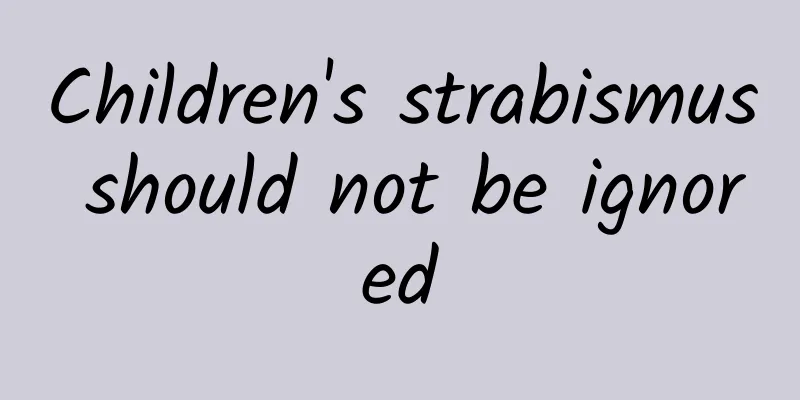Children's strabismus should not be ignored

|
Author: Liu Wen, deputy chief physician, National Children's Medical Center, Beijing Children's Hospital, Capital Medical University Reviewer: Li Li, Chief Physician, National Children's Medical Center, Beijing Children's Hospital, Capital Medical University Strabismus is a common eye disease in children, with a prevalence rate of 0.8% to 6.8%. It is one of the three most common eye diseases in children, along with refractive error and amblyopia. Strabismus in children not only affects the appearance of children, but may also cause amblyopia, affect binocular vision function development and psychological development, and needs to be detected and treated in time. Figure 1 Copyright image, no permission to reprint 1. What is strabismus? Parents often bring their children to the hospital for examination and ask: "Doctor, our child always looks at things with his eyes squinting. Is he strabismus?" In fact, strabismus refers to the inconsistency of the visual axis directions of the two eyes, that is, when one eye is looking at the target, the sight of the other eye deviates from the target, which is manifested as eye deviation. It does not mean that both eyes look in a certain direction at the same time. Strabismus includes latent strabismus, esotropia, exotropia, AV strabismus and vertical torsion strabismus, as well as some special types of strabismus such as dissociative strabismus, eye retraction syndrome, nystagmus, etc., which can occur congenitally or acquired. 2. What are the dangers of strabismus in childhood? To understand the harm of strabismus to children, we must first understand an important concept - binocular single vision. Under normal circumstances, there is a certain distance between the two eyes, which makes the two eyes look at external objects slightly different together. The images of the corresponding parts of the two eyes on the retina are slightly different, but the difference is not very large. After the fusion processing of the visual center of the brain, people will not feel that they are two separate objects, but a complete three-dimensional image with depth perception. This function is called binocular vision or binocular single vision. This is a very important binocular vision function, which can not only improve the visual resolution and expand the field of vision, but more importantly, it provides three-dimensional stereoscopic vision, allowing us to perceive the external space and objects more accurately, and make hand-eye coordination more accurate. It is very important for our study, work, and life. If a child has strabismus, the images seen by the two eyes will be very different, and the brain cannot fuse the two images together, resulting in double vision or binocular vision confusion (aliasing). Double vision is seeing one object as two, and aliasing is when two different objects are imaged at corresponding points on the retinas of the two eyes and are seen as two images in the same visual direction, causing visual confusion. In order to avoid the interference and confusion caused by double vision or binocular vision confusion, the visual system controlled by the brain will automatically "ignore" or "turn off" all or part of the image information of one eye, resulting in "inhibition." Our children are in the critical period of visual development, and this inhibition may affect the development of their vision; at the same time, it may produce abnormal retinal correspondence, affecting the development of stereoscopic vision. Therefore, strabismus in childhood, in addition to affecting appearance, can also lead to amblyopia and loss or severe decline of stereoscopic vision, and may also affect the psychological development of children, and have a serious impact on their future learning, employment, social interaction and quality of life. Therefore, we must detect strabismus in children early and treat it in time. 3. How can parents detect strabismus in their children early? Firstly, some children have obvious eye deviation. Parents can observe that the lines of sight of their children's two eyes are not parallel when they are looking at the target. For example, esotropia can show what we commonly call cross-eyes, that is, the eyes are deviated inward; exotropia can be seen that the eyes drift outward when looking at things, and the line of sight will be "divergent" and "dazed", especially when looking at distance or not concentrating; and sometimes it can be found that one of the child's eyes is rolled up, which may be vertical strabismus. Figure 2 Copyright image, no permission to reprint Some children with intermittent exotropia do not easily show their strabismus under normal circumstances, but may like to squint one eye in strong light, see double images when looking at things with both eyes, or get tired easily after using the eyes for a long time at close range. In addition, if a child likes to tilt his head or look at things sideways, or his eyeballs do not move in the right direction, or the two eyes do not move in a coordinated manner, these indicate that the child may have strabismus. At this time, it is recommended that parents take their children to the hospital and ask a professional doctor to check. At the same time, we will teach you a little trick to check your child's eye position at home - stand facing your child, shine a flashlight into the child's eyes from the front, and observe the position of the light reflected by the child's black eyeball (cornea). Under normal circumstances, the corneal light point should be in the center of the two eyeballs. If the light point of one eye is biased outward, it means that the child may have esotropia, if the light point is biased inward, it means that the child may have exotropia, and if the light point is biased up or down, it means that the child may have vertical strabismus. Another situation is that the child's nose bridge is relatively wide, and there is what we call epicanthus. The white eyeball (sclera) at the inner corner of the eye is partially blocked by the skin of the inner canthus. Visually, the child may look "cross-eyed", especially when looking to the sides, it will feel that the eyes are drilling inward. But in fact, if we look closely, we will find that the child's corneal light reflection point is in the center of the eyeball. If you pinch the bridge of the nose, you will find that the child's eyes are in the right position and symmetrical. In this case, we parents do not need to worry. Figure 3 Copyright image, no permission to reprint 4. What causes strabismus in children? The causes of strabismus in children are relatively complex, including congenital maldevelopment, refractive errors, neuromuscular diseases, trauma, etc. Some may also be secondary to other systemic diseases. Common causes include the following aspects: 1. During the development of a child, if there are abnormalities in the attachment points of the extraocular muscles, excessive or poor development of the extraocular muscles, abnormal development of the nerves that control the muscles, abnormal development of the orbits, and abnormal brain fusion function, strabismus may occur. Sometimes we find that many people in the same family suffer from strabismus at the same time, so some strabismus may also be related to genetic factors. 2. The eye's accommodation and convergence movements are interrelated. If the convergence caused by accommodation is too strong, it may cause esotropia. If the accommodation force is low and the convergence force is also weakened, it may cause exotropia. 3. The vision of both eyes must be basically balanced so that the brain can integrate the objects seen by both eyes into a complete three-dimensional image. If the vision difference between the two eyes is too large, such as monocular amblyopia, congenital cataracts, fundus lesions, ptosis, etc., it will affect the binocular single vision function and cause eye separation, that is, strabismus. Therefore, in fact, many children with monocular vision problems often have strabismus as the first manifestation. 4. Obvious refractive abnormalities, such as anisometropia and/or hyperopia, are high-risk factors for esotropia in children. Myopia, astigmatism, anisometropia, etc. may be high-risk factors for exotropia. 5. Traumatic injury to the head or eye sockets, abnormal development or lesions of the head, face, and brain may also cause strabismus. 6. Premature birth, low birth weight, perinatal diseases, genetic diseases such as chromosomal abnormalities, and adverse prenatal environment (such as maternal drug abuse, smoking, and drinking) are also risk factors for strabismus. Therefore, if you find that your child has strabismus, you must conduct a comprehensive examination to understand the cause of the strabismus. 5. What tests do children need to undergo in the hospital to diagnose strabismus? 1. Medical history inquiry: including chief complaint (type of strabismus, onset time, frequency of occurrence, main strabismus, control status, inducing factors, combined symptoms, etc.), eye disease history and treatment history, perinatal conditions, systemic diseases and medication history, family history, etc. 2. General ophthalmic examination including visual acuity and refraction examination, ocular appearance, anterior segment and fundus, etc. 3. Strabismus specialist examination (1) Eye position examination: including corneal light examination, cover-uncover examination, alternating cover examination, cover plus prism examination, etc. (2) Eye movement examination: Through quantitative examination of strabismus in different diagnostic eye positions, it is possible to understand whether there are abnormalities in eye movement and to analyze and determine whether there are abnormalities in extraocular muscle function. (3) Binocular vision function examination: including synoptophore, stereopsis examination, Worth four-point light, etc. Understanding the child's binocular vision function is of great significance for selecting treatment plans, judging prognosis, and evaluating efficacy. 6. How to treat strabismus in children? The treatment of strabismus depends on the cause, and different treatments are used for different causes. 1. Wear glasses for correction : If the child's strabismus is caused by hyperopia and is an accommodative esotropia, glasses should be worn for treatment first. For patients with intermittent exotropia, if they are accompanied by myopia, high hyperopia, astigmatism or obvious anisometropia, glasses should also be worn for refractive correction first, which will help improve the patient's control over the eye position and reduce the exposure of strabismus. Some strabismus also need to be treated with bifocals or prisms. Figure 4 Copyright image, no permission to reprint 2. Treatment of amblyopia : If the vision development of the two eyes is unbalanced and amblyopia exists, amblyopia treatment is needed to promote the balanced development of binocular vision. 3. Drug treatment : Some strabismus can also be treated with drugs. For example, atropine can dilate the pupil and correct some esotropia caused by abnormal refractive adjustment. Some can also assist in the treatment of amblyopia caused by strabismus. In addition, botulinum toxin can be injected into the extraocular muscles to help eliminate or reduce strabismus. 4. Surgery : For some children, if their strabismus exceeds a certain angle, or their control is very poor, and their strabismus is often exposed, affecting their binocular vision function, they need surgery. Strabismus surgery is to change the force or direction of the extraocular muscles on the eyeball by weakening or strengthening the action of the extraocular muscles or shifting the extraocular muscles to change the muscle's focus point, so as to achieve the purpose of correcting strabismus. Figure 5 Copyright image, no permission to reprint 5. Visual training : If some children are found to have abnormal binocular vision function such as convergence insufficiency during examination, corresponding training can be performed to improve the symptoms. Binocular vision training after strabismus surgery can supplement and consolidate the surgical effect. 7. What is the prognosis for strabismus in children? Strabismus generally cannot heal itself, but through active treatment, most patients can achieve good treatment results. Children with strabismus may have their vision and binocular vision function affected. Visual development is critical before the age of 3 and sensitive before the age of 6. The earlier the strabismus develops and the older the child is, the more difficult it is to restore binocular vision. Therefore, once a child is found to have strabismus, he or she should seek medical attention as soon as possible. The earlier the intervention, the better the prognosis. At the same time, even if children with strabismus achieve good results in the initial treatment, they are still at high risk of developing amblyopia, loss of binocular vision, and recurrence of strabismus. Therefore, regular follow-up is necessary to promptly detect changes in the child's condition and adjust the treatment plan in time according to the situation. |
Recommend
Weak vaginal contractions
The vagina is the most private part of a woman an...
Can I take montmorillonite powder during breastfeeding?
Since montmorillonite powder is a drug that can p...
Can I eat chili peppers during menstruation?
As a condiment, chili pepper plays a very compete...
Why do we look at women's feet?
I believe that very few people know that feet are...
How to stir-fry wild rice stems? Can we eat wild rice stems when they turn red?
The appearance of wild rice is snow-white, with g...
4 things that overdraw your kidneys, some people actually do them every day!
Staying up late for a long time: In the fast-pace...
What happens to a woman without a uterus?
The uterus is unique to women. If a woman loses h...
No clinically significant stones
This is the 4210th article of Da Yi Xiao Hu Among...
Lower left abdominal pain is early pregnancy
In the early stages of pregnancy, many female fri...
Why do children have food accumulation? What are the symptoms and hazards of food accumulation?
Indigestion is easily ignored by parents Food sta...
What should I do if I have my period during a physical examination?
In daily life, people want to know how healthy th...
How women can care for healthy breasts
1. Puberty After women enter puberty, their breas...
Introduction to postpartum episiotomy care methods
Many women who have had a normal delivery are ver...
How many days after menstruation is the safe period
In fact, the safe menstruation period is not rela...
How to reply when a girl says she wants to have a midnight snack? When chatting with her at night, she says she is hungry. Do you want to order takeout?
When a girl says she wants to have a midnight sna...









